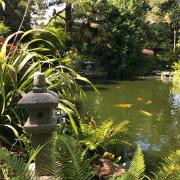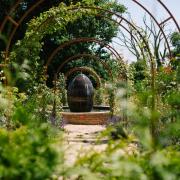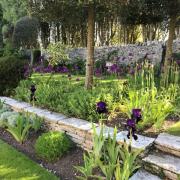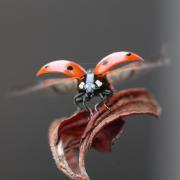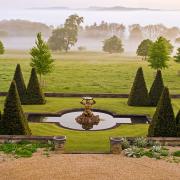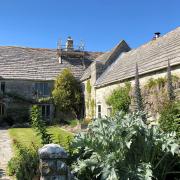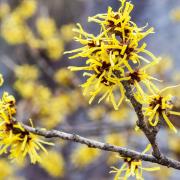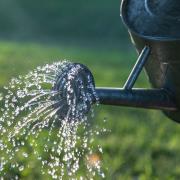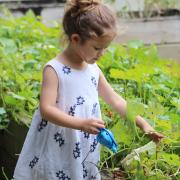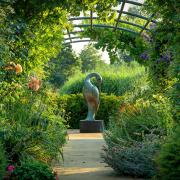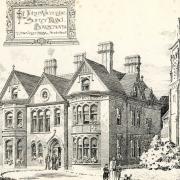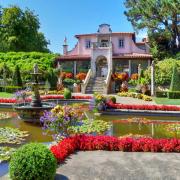Celebrated horticulturist and Chelsea and Hampton Court Flower Show Gold winner, Mary Payne reveals the garden design secrets behind The Wooded Valley at Compton Acres in Poole
Hidden away in the very heart of Compton Acres in Poole, The Wooded Valley is a year-round sensation. This privately owned garden, covering 10 acres, was crafted from Dorset heathland in the 1920’s and is sheltered by a canopy of mature Scott’s pines; it is a captivating wonderland even in the depths of winter.
To me, there are four particular elements of The Wooded Valley which keep it looking spectacular over winter. I hope that sharing these elements and the standout plants with you will provide the inspiration to perhaps try and recreate the essence of the winter Wooded Valley in your own garden.
Attractive Bark
In winter, when the majority of plants have shed their leaves, attractive bark on trees and shrubs grabs the eye. The striking white stems of the West Himalayan Birch, B. utilis var.jacquemontii are a standout feature in The Wooded Valley. For a home garden, the small Paperbark Maple A. griseum is a perfect winter addition with its attractive peeling, papery chestnut-brown bark.
Colourful fruits
Evocative of the season, Hollies produce a bounty of bright red berries over winter. Be sure to get a female variety, such as Ilex X altaclarensis ‘Golden King.’ A favourite at Compton Acres, the Holly I. aquifolium ‘Handsworth Silver’ has exceptional white foliage with contrasting red fruits.
Sought-after scents
To attract what few pollinating insects are around, many winter flowering plants are often powerfully scented. At Compton Acres our scented winter plants include the Mahonia X media ‘Charity’ with its handsomely fragrant yellow flowers. We suggest including the Periwinkle, Vinca difformis at home. A valuable winter bloomer it has sweetly scented icy blue star-shaped flowers.
Exceptional Evergreens
Evergreens bring interesting leaf shapes and colours to The Wooded Valley in winter. A new variety of shrub we have planted is the Fatsia japonica ‘Spider’s Web’ which is truly magnificent with its large palmate leaves that are also heavily mottled with white. Something which also grows particularly well at Compton Acres, and would indeed in a home garden, are camellias. These evergreen shrubs include several winter flowering varieties and feature dark green, ovate and glossy leaves. Bringing wondrous colour, the Camellia X williamsii ‘St Ewe’ is the first to blossom, with clusters of pink flowers in February. At this time of year, the hardy Cyclamen hederifolium provide an attractive carpet of mottled foliage under the trees.
Let’s visit the Wooded Valley
On a clear, crisp, winter’s day take the time to explore the secrets of The Wooded Valley at Compton Acres. You will discover many beautiful and rare plants thriving throughout the winter season. One of five distinct gardens, The Wooded Valley is connected by flowing walkways to the Italian, Japanese, Rock and Water and Heather gardens. Compton Acres is also home to an adjoining Café and Tearooms, Gift shop and Plant Centre featuring many beautiful additions to a winter garden. Open daily
10am -4pm (Last entry 3pm – closed Christmas Day, Boxing Day & New Year’s Day) Find out more at comptonacres.co.uk.
About Mary Payne MBE
Celebrated horticulturist and Chelsea and Hampton Court Flower Show Gold winner, Mary Payne MBE has been consulting at Compton Acres since its purchase by current owners Bernard and Kay Merna in 2003. Mary is a Royal Horticultural Society Master of Horticulture and a former Horticultural Director of the Eden Project. Alongside fellow former Eden Project Horticultural Director, Peter Thoday, the pair has helped to fully restore Compton Acres and breathe new life into the historic gardens. Mary, who lives in Somerset, was awarded an MBE in 2004 for her services to horticulture in the South West. She continues to provide her expertise and advises Compton Acres on all the planting decisions made in the 10 acre gardens.




